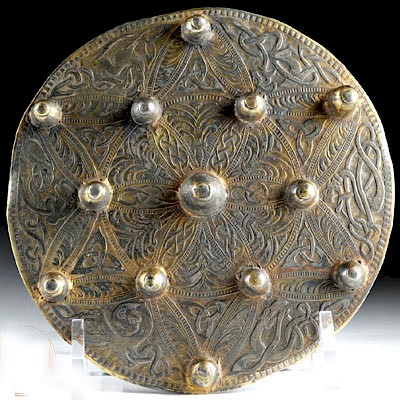Greek Illyrian Bronze Helmet - Xrayed
Lot 16
About Seller
Artemis Fine Arts
686 S Taylor Ave, Ste 106
Louisville, CO 80027
United States
Selling antiquities, ancient and ethnographic art online since 1993, Artemis Gallery specializes in Classical Antiquities (Egyptian, Greek, Roman, Near Eastern), Asian, Pre-Columbian, African / Tribal / Oceanographic art. Our extensive inventory includes pottery, stone, metal, wood, glass and textil...Read more
Estimate:
$25,000 - $35,000
Absentee vs Live bid
Two ways to bid:
- Leave a max absentee bid and the platform will bid on your behalf up to your maximum bid during the live auction.
- Bid live during the auction and your bids will be submitted real-time to the auctioneer.
Bid Increments
| Price | Bid Increment |
|---|---|
| $0 | $25 |
| $300 | $50 |
| $1,000 | $100 |
| $2,000 | $250 |
| $5,000 | $500 |
| $10,000 | $1,000 |
| $20,000 | $2,500 |
| $50,000 | $5,000 |
| $100,000 | $10,000 |
| $200,000 | $20,000 |
About Auction
By Artemis Fine Arts
Jul 19, 2018
Set Reminder
2018-07-19 10:00:00
2018-07-19 10:00:00
America/New_York
Bidsquare
Bidsquare : Fine Antiquities/Ethnographic Art
https://www.bidsquare.com/auctions/artemis-gallery/fine-antiquities-ethnographic-art-3329
Featuring classical antiquities, ancient and ethnographic art from cultures encompassing the globe, plus fine art. Artemis Fine Arts info@artemisgallery.com
Featuring classical antiquities, ancient and ethnographic art from cultures encompassing the globe, plus fine art. Artemis Fine Arts info@artemisgallery.com
- Lot Description
Northwestern Greece, ca. late 6th to 5th centuries BCE. A war helmet made of hammered bronze sheet, rounded in form with a rectilinear opening for the face, long, pointed cheek pieces, and twin parallel ridges on the crown frame the crest. The back and sides flare out slightly to guard the neck and have pseudo-rivets incised around them. Each cheek-guard is perforated at the forward tip, with a perforation at the center of the forehead for attachment of a crest between the two raised parallel double ridges across the crown. Of the type worn by the hoplite phlanx, a rectangular mass military formation, usually composed entirely of heavy infantry armed with spears, pikes, sarissas, or similar weapons. The hoplite phalanx was the perfect manifestation of classical Greek society on the battlefield. Made up of middle-class men who had day jobs, the phalanx was made to decide a war in a single bloody struggle. Size: 9.25" L x 7.75" W x 9" H (23.5 cm x 19.7 cm x 22.9 cm); 12.75" H (32.4 cm) on included custom stand.
These helmets were particularly popular in northern Greece, in the province of Illyria, in the modern day Balkans. They were made for hoplites, the citizen-soldiers of the Greek city states, who often furnished their own bronze armor. As a result, regional styles developed and there is a great deal of variation in shape and form.
Armor was not just for battle, however. The pseudo-rivets on this example show that this was made for parades or to be worn in death - on a battle helmet, those rivets would have been real, to attach to a leather guard. Excavations at Sindos in Macedonia, a necropolis with the remains of Greek soldiers, have found that there was a standardized and probably ritualized method for burial. This included the placement of armor in carefully proscribed areas of the body. The helmet was placed over the head, along with a strip of gold over the mouth and possibly others over the eyes. See similar examples to this helmet from the Metropolitan Museum of Art (1992.180.1, 2006.221, 2003.407.6) and the Louvre (CA 2221Or).
Provenance: ex-private Ketchum, ID collection acquired around 2000, private UK collection acquired in the 1980's
All items legal to buy/sell under U.S. Statute covering cultural patrimony Code 2600, CHAPTER 14, and are guaranteed to be as described or your money back.
A Certificate of Authenticity will accompany all winning bids.
We ship worldwide and handle all shipping in-house for your convenience.
#133436There are two very small fissures along the top crown one in the center ridge, the other to one side. Small stabilized crack at junction of ear plate and front area. Expected surface wear commensurate with age and gorgeous green patina throughout. All-in-all in remarkable condition with virtually no plastic fill so oftem found in helmets of this period.Condition
- Shipping Info
-
All shipping is handled in-house for your convenience. Your invoice from Artemis Gallery will include shipping calculation instructions. If in doubt, please inquire BEFORE bidding for estimated shipping costs for individual items.
-
- Buyer's Premium



 EUR
EUR CAD
CAD AUD
AUD GBP
GBP MXN
MXN HKD
HKD CNY
CNY MYR
MYR SEK
SEK SGD
SGD CHF
CHF THB
THB



















